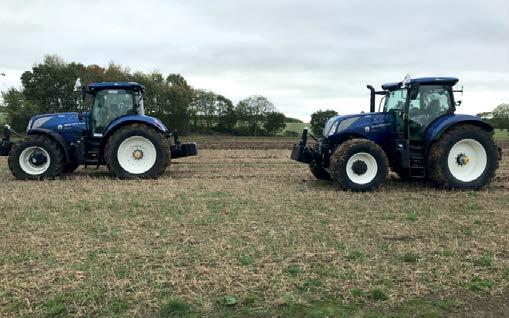AGRONOMIST
IN FOCUS... EVALUATING THE IMPACT OF PESTICIDE USE ON NATURAL CAPITAL
Natural Capital is being measured in novel ways and carbon accounting is now commonplace. It is difficult to be precise about the measurement of the effects of different management practices on soil carbon, so it seems likely that the adoption of management which we know to be more carbon efficient will be a more important short-term yardstick than the increments of this or that measurement of soil carbon. Among the plethora of carbon counting models, one will probably emerge as the dominant approach and, in time, we will all adopt the same standardised system which evaluates our initial progress through the practices we adopt. In the longer term this will be validated through more tangible measures of success, showing the sequestration which can be achieved in the longer run.
David Jones (right) and Mark Dewes assessing the new pesticide metrics at Morley Farms
The position with measurement of carbon is likely to be repeated after a lag in time with biodiversity – the other big area of Natural Capital upon which we have such a large potential impact, both positive and negative. Just as it may be more appropriate to measure the adoption of carbon efficient management than actual soil carbon to assess progress toward Net Zero, it seems we need some effective measurement of pesticide impact to assess our progress toward a reduction on negative effects on biodiversity. Well-planned changes in variety, rotation and agrochemical choice offer significant opportunities to minimise the unintended impact of pesticide use to protect the environment in which we live and work and the soils which we curate. Additionally, we will need to demonstrate this careful management to the wider world. 92 DIRECT DRILLER MAGAZINE
This is the conclusion of studies with a new approach to measurement at Morley Farms in Norfolk (the farming enterprise of The Morley Agricultural Foundation). I have been working on this approach with my old college friend and farm manager, David Jones who does all the farm’s agronomy.
There are no national targets for pesticide impact reduction yet, but the pressure will only grow as pesticide use becomes more of a consideration in our ‘social licence to operate’. For our economic sustainability too, we have to use the products at our disposal in the best-informed and targeted way. Current metrics used in the Pesticide Use Survey including overall weight and treated hectares are of limited use in assessing comparative impact of different pesticide choices as they take no account of the concentration or rate of use of different products. Any improvement of these measures needs to be sufficiently simple and understandable to all concerned to be of real value. Measures like Pesticide Load Index (PLI) and Environmental Impact Quotient (EIQ) based on multiple and often poorly understood factors in complex equations are available, but their complexity and lack of transparency makes them both inappropriate and impractical. Treatment Frequency Index (TFI) appears be a more useful option and has been an important part of the development of pesticide metrics in countries like Denmark. Measuring the number of full rate equivalent applications of each product used per hectare, TFI is quick and easy to calculate from existing field records. This makes it simple to incorporate into existing field recording for individual monitoring by crop, farm, regional and national reporting scales. TFI doesn’t take complete account of the relative equivalence of different pesticides but being based on the full recommended label rate for each product – derived from extensive toxicology and other studies under-pining their official authorisation – it is a good proxy for pesticiderelated harm. To develop TFI further, weightings for specific products from the Harmonised Risk Indicator (HRI) system used within the EU to track the impact of pesticide use. This system awards fewer weighting points for the more
ISSUE 16 | JANUARY 2022























